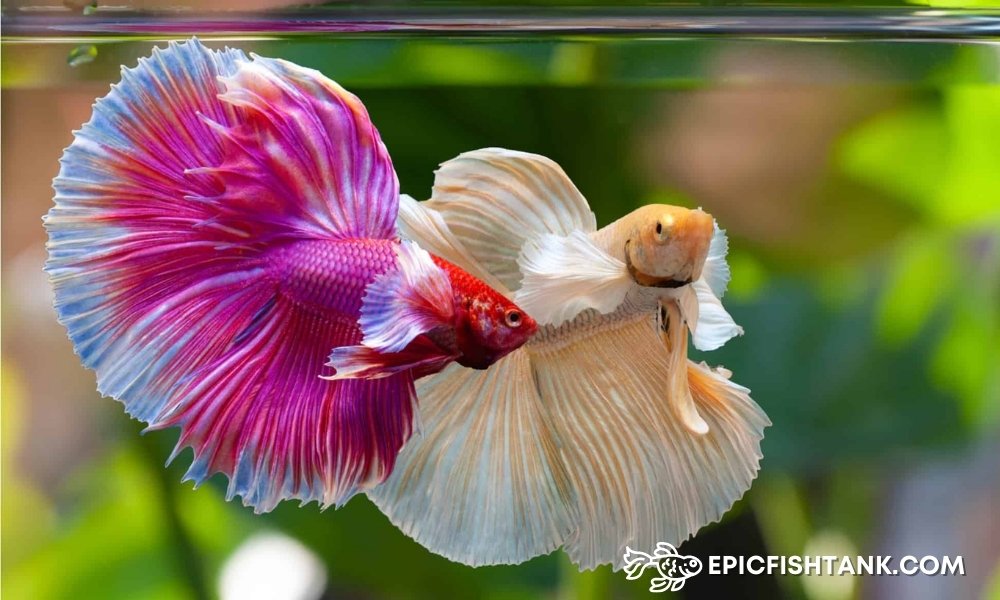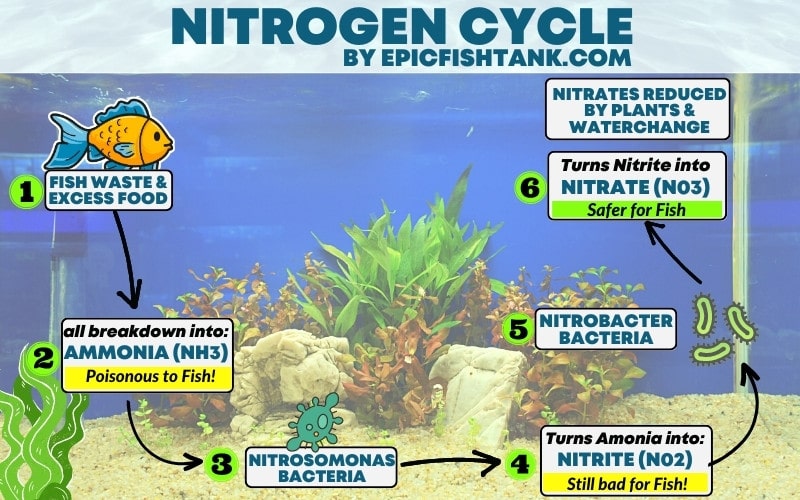The Ultimate Betta Fish Water Change Guide

In this blog post we will show you step-by-step how to change betta fish water safely and properly. So you can enjoy owning these delightful creatures without worrying about whether they’re getting enough care or not. It’s easier than you think!
Guide to proper preparation before betta water change
By preparing new water properly, you can help maintain a healthy environment for your betta fish and prevent health problems such as fin rot, bacterial infections, and other illnesses that can result from poor water quality.
Here’s a more detailed guide on how to prepare new water for a betta fish water change:
| Steps | Description |
| Fill a clean container | Choose a container that is solely used for fishkeeping purposes and fill it with tap water. Do not use a container that has had chemicals or other substances in it that could harm your fish. |
| Use a water conditioner | Tap water contains chlorine and other chemicals that are harmful to fish. Add a water conditioner to the new water to remove these chemicals. Follow the instructions on the bottle for how much to add, based on the size of your container and the amount of water you are changing. |
| Let the water sit | Allow the water to sit for at least a few hours to allow it to reach room temperature. You can also use a thermometer to make sure the water is within a safe temperature range for your betta, which is usually between 75-82°F (24-28°C). |
| Test the water | Use a water testing kit to check the pH, ammonia, nitrite, and nitrate levels in the new water. Make sure the water is safe for your betta before adding it to the tank. |
| Adjust the pH | If the pH of the new water is significantly different from the pH in your betta’s tank, you may need to adjust it slowly over time to avoid shocking your fish. Follow the instructions on a pH adjusting product carefully, as overdosing can harm your fish. |
| Add beneficial bacteria | You can add a beneficial bacteria supplement to the new water to help establish a healthy biological filter in the tank. This will help break down harmful waste products and keep the water clean. |
| Use distilled or RO water | If your tap water is too hard, you may need to use distilled or reverse osmosis (RO) water for your betta’s tank. This will help avoid the buildup of harmful minerals in the water. |
Also Read: Do Betta Fish Need a Filter? No!
How to change the water of a betta fish tank safely

Proper Betta fish water change requires adequate preparation to ensure the safety and well-being of your fish. Once you’ve completed the necessary preparation steps, it’s time to perform the water change correctly.
Here’s an improved step-by-step guide to safely change the water for your betta fish:
Materials needed:
- A clean bucket (aquarium bucket)or container
- Water conditioner
- A siphon or aquarium vacuum
- A small cup or bowl
- Clean towels or paper towels
- A thermometer
- A net
- Gloves (Optional)
Steps:
1. Turn off any equipment in the tank, such as filters or heaters.
2. Use the siphon or aquarium vacuum to remove about 20-30% of the old water from the tank. Follow the instructions that came with the siphon or vacuum to ensure that you are using it correctly. Be careful not to disturb any decorations or plants in the tank.
3. Use the small cup or bowl to scoop out any debris or waste that may have accumulated in the gravel or sand at the bottom of the tank.
4. Use the net to carefully catch your betta fish and place it into the clean bucket or container.
5. Take the thermometer and check the temperature of the new water. Ensure that the temperature is the same as the old water to avoid shocking your betta fish.
6. Add the water conditioner to the new water, following the instructions on the bottle.
7. Slowly pour the new water into the tank, being careful not to disturb any decorations or plants in the tank.
8. Once the tank is filled to the appropriate level, use the net to carefully place your betta fish back into the tank.
9. Turn back on any equipment that was turned off and monitor your betta fish for any signs of stress or illness.
10. Dispose of the old water and clean the small cup or bowl, net, siphon or vacuum, and any other equipment used during the water change.
Performing regular water changes is an essential part of keeping your betta fish healthy and happy. By using a siphon or aquarium vacuum in addition to the other materials listed, you can remove debris and waste from the tank more effectively, leading to a cleaner and healthier environment for your betta fish.
EpicFishTank Note:
When done correctly, water changes should be a maintenance solution that is easy to implement. This link offers you valuable insight into the basics of water changes, making the process as straightforward and effortless as possible!
How To Change Betta Fish Water Without Siphon?
If you don’t have a siphon, you can still change your Betta fish’s water. All you need is a bucket and a scoop or similar apparatus to remove the old water.
First, turn off any filters or heaters to prevent them from being damaged during the water change. Gently scoop out the old water from the tank and transfer it to the bucket, repeating the process until you have removed the recommended amount of water.
While you wait for the new water to condition, take the opportunity to clean any decorations or plants in the tank. Refill the tank with the new, conditioned water, being careful not to disturb any decorations or plants.
Turn on the filters and heaters and wait for the water to stabilize for at least 30 minutes before transferring your Betta fish back to the tank using a net.
Monitor your Betta closely for the first few hours after the water change to ensure that they are adjusting well. This process is simple and easy, and you can change your Betta fish’s water without a siphon in no time.
Tips for Monitoring the Nitrogen Cycle During Water Changes
Additionally, as you are performing water changes, remember to monitor the nitrogen cycle closely as it is essential to keeping your betta fish healthy and happy!

3 tips for monitoring the nitrogen cycle during water changes:
- Use a water testing kit: A reliable water testing kit will help you monitor the levels of ammonia, nitrites, and nitrates in your betta tank. You can find them in most pet stores or online.
- Keep track of the results: Record the results of your water tests in a notebook or use an app to keep track of them over time. This will help you identify any patterns or changes in your tank’s nitrogen cycle.
- Clean the filter: The filter is an essential component of the nitrogen cycle, so make sure to clean it regularly to prevent the buildup of debris and other waste.
EpicFishTank Note:
Taking care of a betta fish is not hard, but it requires that you stay up to date on his water changes. You’ll need to do water changes at least every two weeks, with larger and more frequent changes being necessary for sick or elderly bettas.
One of the most important things to keep in mind when changing the water is to maintain the nitrogen cycle- without this balance, ammonia and nitrites can quickly become toxic to your fish, leading to serious health complications.
How much water should you change?
The quantity of water that needs to be changed is influenced by two factors: the stocking density in the tank and the tank size. Both factors have a significant impact on the overall water quality.
If you have several tank mates along with your Betta fish, the buildup of toxins in the tank will be more rapid, and you will need to change the water more frequently.
On the other hand, in a small tank, the ratio of water to toxins can become dangerously imbalanced more quickly than in a larger tank with a suitable body of water.
Here’s a table that shows the recommended water changing checklist based on the size of the tank:
| Tank Size | Water Change Checklist |
| 2.5 gallons or less | Change 50% of the water every week |
| 5 gallons | Change 30-50% of the water every week |
| 10 gallons or more | Change 10-25% of the water every week |
EpicFishTank Note:
Frequent water changes are crucial for the well-being of your Betta fish. It is generally recommended by experts to change your Betta’s water at least once a week.
However, in case your Betta’s habitat becomes excessively dirty, you may have to change the water more frequently to maintain a healthy and clean environment for your fish.
Final Words
By following the tips and guidelines outlined in this guide, you can ensure that your betta’s home remains clean and safe, while also promoting their overall well-being.
Remember to pay attention to the nitrogen cycle and monitor your water quality regularly, as this will help you catch any issues early and take corrective action as needed. With a little effort and attention, you can enjoy a beautiful and thriving betta fish habitat for years to come!
References
- Youtube Video | How to do a Water Change on a Betta Fish Tank
Time for a coffee break! With your support, We can keep working hard and creating fantastic content. #let's make it happen!
Author
Reza is a digital marketer and an avid freshwater aquarist. He's been keeping fish tanks for more than 10 years and has always been fascinated by the delicate balance of life in water.
Reza loves to share his knowledge about both digital marketing and fishkeeping with others, and he is always happy to help new aquarists get started in this rewarding hobby.
Wibisono is a freshwater fish breeder who raises and breeds different species of ornamental fish like betta, guppy, flowerhorn, and goldfish. He has been in the business since 2018 and exports his fish to different countries. He is committed to providing high-quality and healthy fish to his customers.

Leave a Reply